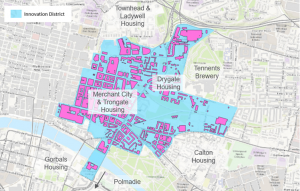A Vision for a Climate Neutral and Climate Resilient Innovation District
 Roddy Yarr, Assistant Director of Sustainability at University of Strathclyde and Board Member for Climate Ready Clyde outlines his thoughts on what it would look like for GCR to be flourishing in its future climate, and how the University of Strathclyde is contributing to get us there.
Roddy Yarr, Assistant Director of Sustainability at University of Strathclyde and Board Member for Climate Ready Clyde outlines his thoughts on what it would look like for GCR to be flourishing in its future climate, and how the University of Strathclyde is contributing to get us there.
I was recently asked what I think the city where I work would look like if it were to realise its climate ambitions. The musing below is what I imagine when I close my eyes and try to place myself into the future. It is 2030 and I have walked down High Street to the Saltmarket to the River Clyde. I am standing on Clyde Street looking over the river taking in the view and the sights and sounds.
The city environment I have worked in for 15 years is now a place for pedestrians with improved air quality and green spaces in abundance. That buzz and vibe of the city is still there but now I can hear birds singing and the river is busy with electric powered river taxis, boats, paddleboards and people enjoying the mighty Clyde as a leisure and transport corridor. The river that forms the backbone of the city has been transformed into a resilient and vibrant space for the city. It just looks and feels completely different – alive. I can make out the team of heat pump energy centres with their solar panels and floating reedbeds on the river that provide heat and cooling for the city’s universally affordable carbon neutral district energy network. The river is energizing the city. A city that is happily car free with active travel and public transport connecting communities and providing well being benefits.
Parking places that used to dominate either side of the street are now given over to wide footways and accessible spaces for people with trees and parklets for residents to enjoy. Cyclists can move easily along the streets. People can walk and wheel safely uninterrupted from what used to be a car-centric space. The trees planted some years ago are now well established and they clearly provide biodiversity, cover and shade to keep residents and visitors cool when it gets too hot, helping with the city’s resilience agenda. In fact, the trees define the city and from overhead the canopy across the city has now truly transformed it into a wee green place.
It’s hard to imagine all this but we have created climate corridors on our main streets that form a new network of climate interventions with all of the low carbon services now installed and easily accessible. They are future proofed and the city is now much more resilient. It can handle the shocks that climate change delivers better and it is thriving. The city’s surface water drainage is now replumbed with attenuation built in on green roofs and in green parklets for people and wildlife to share and enjoy. Green walls and city buildings have been adapted to cope with the more intense rain storms that happen now.
Some might say that this is ‘pie in the sky’ but Glasgow, like many European cities that we know and love is already thinking of these things. Climate Ready Clyde’s vision shares many of these bold ambitions, as does the University of Strathclyde. Our climate social responsibility work to integrate mitigation and adaptation solutions, well-being and to bring communities together exemplifies this. The University is leading with Glasgow City Council to look at a whole systems approach to create a Climate Neutral Innovation District. The solutions we bring forward from this technical work will be designed to be fundable, costed, deliverable, replicable and at scale.
The bold and ambitious vision for the city is to create a ‘100% renewable Climate Neutral, Climate Resilient’ Glasgow City Innovation District that integrates heat, power, transport, climate adaptation and well-being solutions that are socially inclusive. This will use our natural resources and will add climate solutions to existing and planned urban development plans to act on climate impact. This will incorporate the deployment of ‘at scale’ infrastructure such as: heat pumps in the River Clyde; city scale DH network planning and delivery; smart grids and systems that enable heat and power and transport flexibility for businesses and residents; adaption solutions and smart streets where pedestrians are prioritised and that are accessible for all and which encourage active travel. This ‘whole systems’ approach will be a first for Scotland and for Glasgow.
Extending from Cathedral Street, down High Street to the River Clyde, the Innovation District is a 170Ha area in the heart of Glasgow. The site has direct access to the River Clyde, a huge river catchment of 3,200km2 with 1GW of heat potential. In this Local Air Quality Management Area, the partners will create a climate neutral Glasgow City Innovation District that mitigates and adapts to current and future climate conditions. ‘Climate Corridors’ will be created that will enable energy distribution to business and communities, low carbon transport and adapted spaces.
The technical feasibility work now underway and led by the University of Strathclyde focuses on solutions for large scale urban infrastructure deployment that is adapted to climate change. Infrastructure solutions that are socially inclusive and delivered as part of already planned and funded major city infrastructure projects such as the City Deal Avenues at Cathedral Street, George Street, High Street, the ‘Places for Everyone’ work and the update of the District Regeneration Frameworks in the city, Mission Clyde, Clyde ReBuilt. These new solutions in our streets, linking businesses and communities will transform our streetscape and spaces so that they act as resilient climate and energy corridors as part of large-scale urban realm planning to meet net zero and climate targets.
The solutions will transform the city and they will enable the local community to benefit from distributed and affordable heat, power and active travel systems, helping to relieve fuel poverty and enable societal benefit. The solutions will tackle air quality in the centre of Glasgow. They will purposely ‘green’ Glasgow with less cars in the core city area and accelerate green transport systems, active travel infrastructure, green infrastructure that improves biodiversity and more space for people first and foremost. Circular economy construction solutions will be at the heart of all new infrastructure, so that the use of resources is optimised.
The footprint of the Glasgow City Innovation District

Contact – Dr Roddy Yarr, Project Sponsor, University of Strathclyde